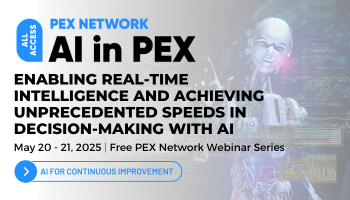10 trends impacting intelligent automation right now
Learn what's shaping the current intelligent automation landscape
Add bookmark
Intelligent automation (IA) systems and robotic process automation (RPA) are not new to process excellence professionals. However, advanced technology like artificial intelligence (AI) and demand for companies to become leaner and more efficient are having a profound influence on automation.
Don't miss any news, updates or insider tips from PEX Network by getting them delivered to your inbox. Sign up to our newsletter and join our community of experts.
The landscape is rapidly changing. PEX Network recently assessed what's happening and how to evolve in step with IA and RPA. At the All Access: Intelligent Automation & RPA webinar series, thought leaders and audience members had interesting conversations about the movement in this space – with some clear themes emerging.
1. Automation is not always the answer
Ironically, in a conversation about automation, experts revealed that it is never all about automation. For a while now, many organizations have seen automation as a panacea. They can save money, improve efficiency and have fewer employees to engage. However, some processes are better candidates for automation than others.
"Can you automate any process?" asked Ramnath Natarajan, director of the Global IA Center of Excellence. "The answer is, no, you can't automate all processes. You just need to pick the right automation."
Natarajan stressed that considering the reasons why an organization is choosing to automate a certain process, along with the role humans play and assessing risk, should all be part of decision-making.
2. Machines don't have to replace people
People have lots of fear about automation. They think it will steal their jobs.
"When I first started doing RPA work and building the team at American Family Insurance, I was really worried about having to overcome concerns that folks might have where they might be reticent to share, for example, expertise and subject matter knowledge about business processes that might be good candidates for automation in practice," said Benjamin Coblentz, senior manager, data and technology at American Family Insurance. "It's been my experience that really has never materialized as an actual issue."
Part of that is a results of building trust through effective communication, and being honest about what our intentions are within an organizaiton, he added. "We've been very intentional and direct in explicitly stating the intent of automation is not to displace workers or to replace or eliminate. Our experience has actually been that folks welcome automation when we implement it because it's taking some of those more repetitive, robotic types of tasks off their plate, so they can focus on those higher level activities."
WATCH: Coblentz and PEX Network Advisory Board member Vineet Mehra discuss ethical automation
3. Manage talent budgets
"Hire, don't fire," is a mantra of Doug Shannon, global IA and generative AI thought leader and influencer. He explained that automation does not have to mean layoffs if companies are smart and create realistic hiring budgets that consider automation. They also must continuously train people as technology evolves.
"You see that in the news where these large companies say, 'Let's get rid of 10,000 people.' I think that is the opposite of what we should be doing," said Shannon. "That is classical thinking, and it's not good for the morale. It's not good for the people. I don't know how people would trust to even work there after that."
WATCH: A fireside chat with Shannon about AI's impact on IA
4. Automation: Good for the people
In fact, there are benefits to automating an appropriate process. For one, automation can make the humans look good.
"It's not just the outcome of automation that the job will be reduced, but then it's also about how automation can give you better access to data and information that you didn't have," said Vineet Mehra, product head, global process owner at AP Moller Maersk. "Then you can invest your time in doing a lot of better analytics and supplier management and vendor relationship management activity. So, there's constant needed for us to keep training and keep the user base slightly more informed about what the automation is for and what it is not for."
5. Digital mindset: A must-have skill
In the era of IA and AI, a digital mindset is pivotal. Understanding what that means can go a long way to easing anxiety.
"Now, of course, the biggest question that comes up is what is a digital mindset? Is it that everyone in the organization needs to know how to start coding suddenly or how to work on different tools and technology? Not really. Digital mindset is simply how well you are able to connect the output of data algorithms and technology to solve a real world business problem," said Tariq Munir, APAC financial planning transformation lead at PepsiCo.
WATCH: Munir talks with PEX Network Advisory Board member Nao Anthony about leadership in automation
6. Assess the technology
With all the advanced technology showing up on the scene, many people are overwhelmed. Taking stock of the available technology and determining the right fit for the organization and its goals is a priority. Rejection is a must if the shiny, new object is not a match.
"How can we be clear when it comes to capabilities and leveraging capabilities? How would that solve business needs? If the answer is that it doesn't, it's okay to say no," said Nao Anthony, senior manager, operational excellence at Commonwealth Bank.
Choosing not to invest in the latest technology or observing how it works for others first might not be a bad idea. Sometimes, it's alright to avoid following the crowd.
7. Automation silos: The struggle is real
Silos can break a business. Unfortunately, automation often gets divided into the departments where it's happening. If different teams and individuals fail to communicate, no one can learn from each other's mistakes or make good decisions about moving forward, correcting errors and increasing efficiency and productivity.
"If we can successfully break down automation silos, we can immediately be impactful...I totally believe in that," said Deji Adedayo, IA lead and product owner (North America) at Gordon Food Service. "Also, we can improve innovation within the organization. Without breaking down those silos, innovation is not going to happen. There's no way. So you need to break down those silos, and then we'll see growth in innovation and improvement in efficiency. Then we also build very good automations."
To ensure the removal of silos, organizations must foster a culture of collaboration that includes safe spaces for communication and transparency. They must also put teams in touch with each other, so they share resources, best practices and information about the automation projects.
WATCH: Adedayo and Natarajan discuss automation silos
8. AI's impact is fierce
AI is certainly having a moment, and its impact on IA is obvious. It's making automation more accessible to a wider group of professionals. However, it's still in its infancy, and there are many unknowns. While people should be experimenting, they must have their eyes wide open.
"When we operationalize AI, we need to take into consideration two primary aspects," said Juan Jiménez-Huyke, lead product strategy engineer at Appian. "First of all, evaluating the risk and having a a suitable digital strategy to support AI as we implement it into our operation."
WATCH: Juan explains why risk management is required in the age of transformative AI
9. Encourage curiosity
To succeed, people must continue to wonder and have an interest in understanding technology. Continuous learning will be the air those who succeed breathe.
David Sentongo, senior director product strategy at Tungsten Automation, offered advice to leaders trying to ensure their teams are prepared for the changes brought by generative AI. "Embrace it and empower people to be thought leaders to bring their insights and learnings, creating a culture of curiosity."
His point is that people must have the desire to keep finding out about the latest technology and how to apply it to their work, so organizations must supply continued training.
WATCH: Sentongo describes the problems and solutions with integrating AI into automation
10. Automation as key to survival
Automation can be a solution to some of a business' most pressing problems. It's not always the answer, and it does not have to replace talent. Leaders must educate themselves, embrace technology and have a thoughtful automation strategy in place.
WATCH: Bachenheimer explores digital transformation
"Automation, even going back when I started six years ago, was a good cost-saving technique. It's moved beyond that these days. Automation isn't a science project or something to save a couple of dollars here or there," said Lou Bachenheimer, PhD and CTO of Americas, SS&C Blue Prism. "It is a necessity if you want to compete in business. All the analysts are agreeing that if you don't have a scaled out IA strategy, you're setting yourself up for failure."
All Access: AI in PEX is 2025

All Access: AI in PEX 2025 is designed to address these challenges and empower organizations to successfully integrate AI into their process improvement initiatives. The content series will bring together industry experts, thought leaders, and practitioners to share insights, best practices, and real-world case studies.
Register Now


















